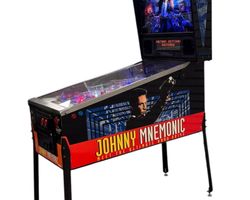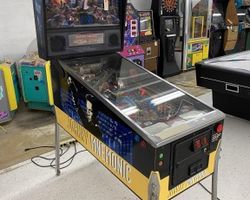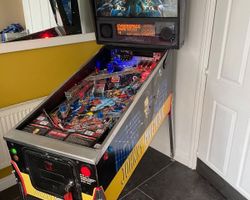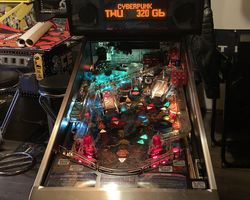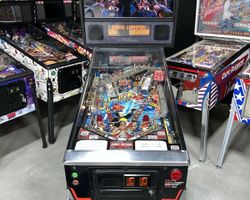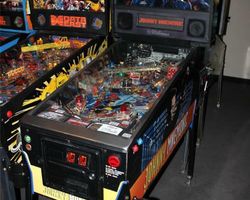Johnny Mnemonic
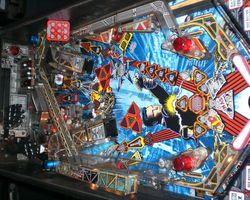
Average Prices: USD $800 to $2,700
Produced: August, 1995
Production Run: 2,756 units
Machine Type: Solid State Electronic
MPU: Williams WPC Security (WPC-S)
Players: 4
Design by: George Gomez
Art by: John Youssi
Dots/Animation by: Adam Rhine, Brian Morris
Mechanics by: Tom Kopera
Music by: Dave Zabriskie
Sound by: Dave Zabriskie
Software by: Tom Uban
The pinball machine "Johnny Mnemonic," released by Williams Electronic Games, Inc. in August 1995, brought the cyberpunk world of its namesake film to the arcade. Despite the film's lukewarm reception, the pinball machine carved out its own distinct identity, becoming a notable entry in the latter era of Williams' WPC (Williams Pinball Controller) system, specifically running on the WPC Security (WPC-S) board. Designed by George Gomez, with artwork by John Youssi, music and sound by Dave Zabriskie, and software by Tom Uban, the machine aimed to capture the essence of a high-tech, data-driven future. Its production run of 2,756 units makes it a relatively common yet sought-after title within the pinball community, often celebrated for its distinct gameplay attributes rather than its cinematic tie-in.
The creative team behind "Johnny Mnemonic" included several experienced figures from Williams. George Gomez, known for his ability to craft engaging layouts, envisioned a fast-paced game that integrated innovative mechanical features. John Youssi's artwork aimed to translate the film's aesthetic into a vibrant playfield and cabinet, while Dave Zabriskie's sound design provided the sonic backdrop for a world of data couriers and corporate intrigue. The machine’s development journey took place during a period of significant innovation for Williams, as they continued to push the boundaries of mechanical and software integration in pinball. One interesting tidbit from its development is the inclusion of "Midnight Madness," a special mode that activates when the internal clock hits midnight, a playful nod to a feature found in some earlier Williams machines. Furthermore, the game features audio Easter eggs during its "Frenzy" mode, where players can hear voice calls reminiscent of other Williams games, including the distinct laugh of Rudy from "Funhouse."
Signature Features and Design
"Johnny Mnemonic" distinguishes itself with several unique mechanical and design elements that shape its gameplay and overall appeal. The standout feature is undoubtedly the magnetic ball lift, often referred to as the "Glove" or "Magnetic Hand" assembly. This mechanism physically catches the pinball from a playfield shot, holds it magnetically, and allows the player to manually move the hand assembly over a grid of nine slots using the flipper buttons. The player then strategically releases the ball into one of these "Cyber Matrix" slots, each offering a distinct award that varies per game. This innovation provides a temporary pause in the otherwise frenetic action, introducing a moment of deliberate player interaction and choice.
Complementing the Glove is the Cyber Matrix Ball Lock assembly itself. This grid of nine illuminated slots serves as both a ball lock mechanism and a dynamic award system. Balls locked here contribute to multiball modes or activate various awards chosen via the Glove. The integration of the mechanical hand with the Cyber Matrix creates a central interactive hub on the playfield, enhancing immersion by directly linking player actions to specific game outcomes. Beyond these signature mechanics, the machine utilizes a Dot Matrix Display (DMD) for animations and scoring, providing visual feedback that complements the futuristic theme. An automatic plunger system ensures consistent ball launches, contributing to the game's high-speed flow.
Playfield and Mechanics
The "Johnny Mnemonic" playfield layout, designed by George Gomez, emphasizes speed and shot flow. It features two flippers, three pop bumpers, and two slingshots that keep the ball in constant motion. Two ramps dominate the upper playfield, providing satisfying shots that feed the ball back down for rapid-fire action. A single drop target bank adds an element of precision shooting, often revealing access to specific modes or awards. The strategic placement of shots creates a rhythm of continuous action, rewarding players who can consistently hit flowing ramp shots and navigate the upper playfield.
The layout's design philosophy leans into high-velocity play. Shots are generally smooth and well-defined, allowing for combo opportunities. The left orbit shot feeds into a spinner, adding a satisfying sound and visual effect as the ball races around. The right side of the playfield is dominated by the entrance to the Cyber Matrix and the magnetic Glove mechanism. This area becomes a focal point for strategic decision-making, as players aim for the shot that feeds the ball to the Glove, then carefully choose their Cyber Matrix award. The playfield artwork by John Youssi reinforces the cyberpunk aesthetic with circuit board patterns, digital interfaces, and character likenesses from the film, albeit with some criticism regarding its overall vibrancy compared to other titles of the era. Lighting, while functional, focuses on highlighting active shots and mode progression, maintaining a clear path for the fast-moving ball.
Gameplay Dynamics
The gameplay experience in "Johnny Mnemonic" is defined by its fast pace and emphasis on shot consistency. The scoring system rewards rapid shot chaining and successful completion of various game modes. The game features multiple multiball opportunities, including a 2-ball "Touch Tone Multiball," a "Quick Multiball," and a primary 3-ball Multiball, each designed to escalate the excitement and scoring potential.
A key objective for players is to activate and navigate the "Cyber Matrix," which offers various awards such as points, extra ball opportunities, and mode starts. The strategic use of the magnetic Glove to select desired awards from the nine-slot matrix introduces a layer of decision-making beyond pure shot execution. The game’s unique modes include a "Video Mode" titled "Snarf!," a Pac-Man-like mini-game on the DMD where players control a bouncing character to collect dots, with an extra ball available in the second round.
The ultimate objective for skilled players is to reach the wizard mode, "Power Down." This intense 4-ball multiball experience tasks players with keeping all balls in play while the pinball machine progressively "shuts down" its lights and features, mimicking a system failure. The virtual character guiding this mode is voiced by Steve Ritchie, adding another familiar voice to the game's audio landscape. "Power Down" is a test of endurance and control, distinguishing itself as a memorable wizard mode. Successful gameplay often involves mastering the Glove mechanism, consistently hitting ramp shots, and navigating the various multiball opportunities to build score and progress towards the wizard mode.
Reception and Legacy
"Johnny Mnemonic" garnered a generally positive reception within the pinball community, particularly in the years following its release. Its strengths primarily lie in its gameplay and unique mechanical features. Players frequently praise its "lightning-fast" and "furious" gameplay, highlighting its excellent shot flow that encourages chaining combos. The mechanical Glove, despite some initial concerns about its potential to disrupt flow or malfunction, is largely regarded as a cool, distinctive, and strategic feature that adds depth to the game. The "Cyber Matrix" ball lock also receives acclaim for its innovative approach to ball management and award selection.
The machine's rules and modes are considered well-designed and varied, with the "Power Down" wizard mode often cited as a challenging and compelling highlight. The music and sound effects are typically viewed as fitting for the cyberpunk theme, contributing to the overall atmosphere. Furthermore, "Johnny Mnemonic" is frequently mentioned as an "underrated" game, offering considerable gameplay value for its market price, especially when compared to other machines of its era. The smooth and satisfying feel of its primary shots is also a consistent point of praise.
However, the machine does have its points of criticism. The primary detractor for many is its association with the "Johnny Mnemonic" film, which was not well-received. Some players found the Glove mechanism too slow or susceptible to issues, occasionally interrupting the game's inherent speed. The artwork, while functional, is often described as "average" or "subpar" by some collectors, and the cabinet art can be prone to fading over time. Repetitive callouts and a video mode that many players found unengaging are also noted weaknesses. Additionally, some reports indicate imbalances in the scoring system, and a few players found ramp shots to be overly difficult or prone to causing immediate drains. Despite these criticisms, "Johnny Mnemonic" has maintained a solid reputation as a "sleeper" title. It stands as an example of a pinball machine that transcends a less-than-stellar licensed theme through engaging gameplay and mechanical innovation, solidifying its place as a machine valued for its playing experience.
Sponsored Links
 Ebay Listings
Ebay Listings
 Auction Results
Auction Results
| Cost | Location | Date |
|---|---|---|
| USD $3,250 |  California, United States California, United States |
10 June, 2025 |
| USD $3,000 |  Arizona, United States Arizona, United States |
15 April, 2025 |
| USD $6,000 |  California, United States California, United States |
21 February, 2025 |
| USD $2,850 |  Pennsylvania, United States Pennsylvania, United States |
10 January, 2025 |
| USD $3,800 |  Michigan, United States Michigan, United States |
25 October, 2024 |
| USD $3,650 |  Florida, United States Florida, United States |
12 July, 2024 |
| USD $4,900 |  South Carolina, United States South Carolina, United States |
14 April, 2024 |
| USD $3,850 |  New Jersey, United States New Jersey, United States |
08 March, 2024 |
| USD $4,000 |  Utah, United States Utah, United States |
08 January, 2024 |
| USD $4,000 |  North Carolina, United States North Carolina, United States |
20 May, 2023 |


Private Policy · Search Website · Contact Us
As an eBay Partner, we may earn a commission from qualifying purchases made through links on this site, at no additional cost to you.
All trademarks and copyrighted materials remain property of their respective owners. All other content copyright 2007 - 2025 Pinpedia.

